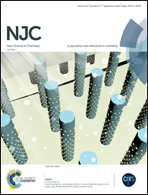Sensitive detection of enrofloxacin using an electrochemiluminescence immunosensor based on gold-functionalized C60 and Au@BSA nanoflowers†
Abstract
A novel competitive electrochemiluminescence (ECL) immunosensor based on CdSe quantum dots was developed for the detection of enrofloxacin (Enro). Fullerene (C60) as a substrate is chemically surface modified using L-cysteine to obtain better water solubility and abundant amino and thiol groups that can load Au nanoparticles. The loading of Au can not only anchor the antigen, but also accelerate the electron transfer at the electrode surface. Since flower-like Au@BSA nanoparticles have abundant amino groups and a large specific surface area, they can act as a probe carrier. In other words, they can immobilize a large number of CdSe QDs via an amidation reaction to amplify the ECL signal. The Enro antigens as well as Enro analytes can connect with Enro antibodies that bind to Au@BSA through gold–nitrogen bonds. As the concentration of analytes increase, their ability to compete with antigens increases. So the number of antibodies bound to the antigens on the electrode decreases. This means that the number of CdSe QDs connected to the antibodies also decreases, resulting in a relatively low ECL response. The ECL intensity is linearly related to the Enro concentration in the range of 0.001–20 ng mL−1 with a detection limit of 0.33 pg mL−1.



 Please wait while we load your content...
Please wait while we load your content...